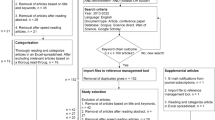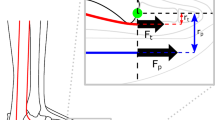Summary
A group of 44 persons who had completed a hike of 100 km were examined for changes in the form of the sole of the foot. A foot print was taken before and after the hike, using a plantographic print method. In evaluating the plantogram, the Chippaux and Clarke method was employed. On the whole, it was observed that there was no significant falling of the arch as a result of the hike. Only among those persons who had had fallen arches before the hike was there a further falling of the longitudinal arch.
Zusammenfassung
Es wurde die Form der Fußfläche bei einer Gruppe von 44 Fußgängern geprüft, welche einen 100 km-Marsch absolvierten. Die Fußflächenform wurde vor und nach dem Marsch mittels einer plantographischen Abdruckmethode aufgezeichnet. Die Plantogramme wurden nach der Chippaux- und Clarke-Methode ausgewertet. Im ganzen betrachtet war bei den untersuchten Personen keine signifikante Senkung der Fußwölbung als Folge des Marsches festzustellen. Nur bei denjenigen Probanden, die schon vor dem Marsch einen Senkfuß aufwiesen, war eine weitere Senkung der Längswölbung festzustellen.
Similar content being viewed by others
Literatur
Basmajian, J. V., Bentzon, J. V.: An electromyographic study of certain muscles of the leg and foot on the standing position. Surg. Gynec. Obstet. 98, 662–666 (1954).
—, Stecko, G.: The role of muscles in the arch support of the foot. J. Bone It Surg. 45, 1184–1189 (1963).
Chippaux, C.: Elements d'anthropologie. Marseille 1947.
Clarke, H. H.: An objective method of measuring the height of longitudinal arch in foot examinations. Res. Quart. Amer. Ass. Hlth phys. Educ. 4, 99–106 (1933).
Gray, E. G., Basmajian, J. V.: Electromyography and cinematography of leg and foot (normal and flat) during walking. Anat. Rec. 161, 1–16 (1968).
Hicks, J. H.: The action of muscles on the foot in standing. Acta anat. (Basel) 27, 180–192 (1956).
Hora, K.: Somatische Änderungen nach langjährigem Fußballspielen. [Tschechisch.] Spisy lék. Fak. Masaryk. Univ. 4 (1931).
Jones, R. L.: The human foot. The experimental study of its mechanics, and the role of its muscles and ligaments in the support of the arch. Amer. J. Anat. 68, 1–39 (1941).
Lelièvre, J.: Lésions du pied chez les dentistes. Rev. franç. Odonto-stomat. 8, 502–508 (1962).
Mironova, E. S., Gorinova, R. L.: Änderungen der Höhe der Längswölbung des Fußes nach der Belastung bei Sportlern verschiedener Art. [Russisch.] Teor. Prakt. fiz. Kult. 8, 21–28 (1962).
Nizankovski, C., Wanke, A.: Der Fuß-Sohlenwölbungsindex bei berücksichtigten Sportdisziplinen. Sportärztl. Prax. 13, 169–175 (1960).
Novotny, V., Tamassyova, E.: Fußwölbung bei den Langstreckerradfahrern der höheren Leistungsklassen. [Tschechisch.] Telovych. Sbornik 9, 247–254 (1966).
Novozamsky, V., Buchberger, J., Kvapilik, J.: Changes of the foot arch in static strain. Acta Univ. Carol. Gymn. 1, 77–81 (1966).
Sheffield, F. J., Gersten, J. W., Mastellone, A. F.: Electromyographic study of the muscles of the foot in normal walking. Amer. J. phys. Med. 35, 223–236 (1956).
Smirak, J.: Beitrag zur Problematik des Plattfußes bei der Schul- und werktätigen Jugend. [Tschechisch.] Acta Univ. Pal. Olm. Biol. I. Suppl. (1960).
Smith, J. W.: Muscular control of the arches of the foot in standing: an electromyographic assesment. J. Anat. (Lond.) 98, 152–163 (1954).
Stelzner, F.: Der Fuß im Stand und im Marsch. Z. Anat. Entwickl.-Gesch. 112, 229–244 (1942).
Tschogovadze, A. V., Placheta, Z.: Die Fußgewölbe bei Sportlern der höheren Leistungs-klassen. Med. u. Sport 5, 92–98 (1965).
Turnbull, G. McL.: A radiological investigation of weight-bearing changes in the human foot. Med. J. Aust. 2, 455–456 (1949).
Zarnach, Z.: Klinische und röntgenologische Veränderungen des Fußes bei älteren Fußballspielern. Sportärztl. Prax. 2, 50–51 (1961).
Author information
Authors and Affiliations
Rights and permissions
About this article
Cite this article
Novozamsky, V., Buchberger, J. Die Fußwölbung nach Belastung durch einen 100 km-Marsch. Z. Anat. Entwickl. Gesch. 131, 243–248 (1970). https://doi.org/10.1007/BF00520967
Received:
Issue Date:
DOI: https://doi.org/10.1007/BF00520967




